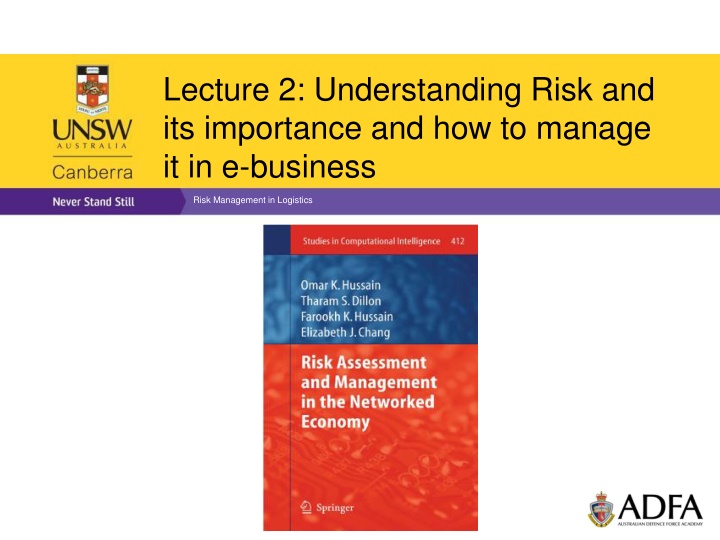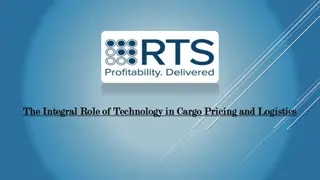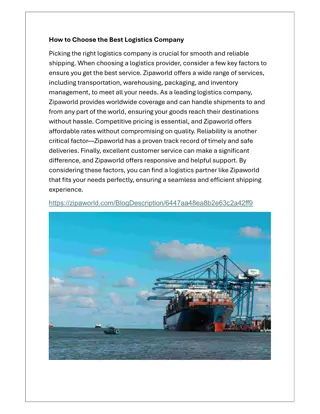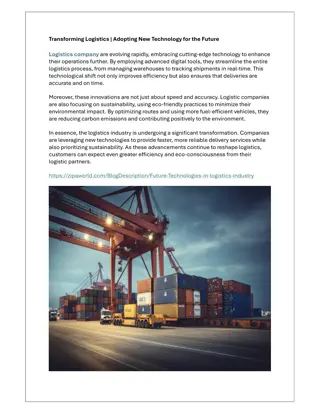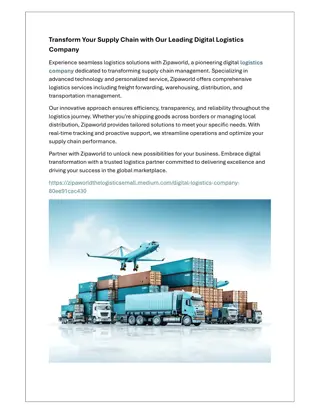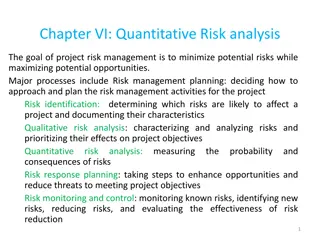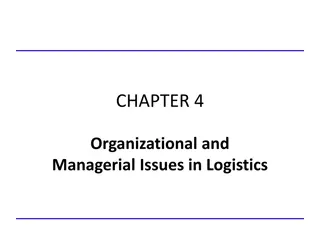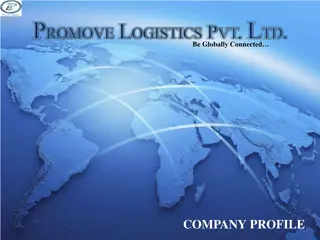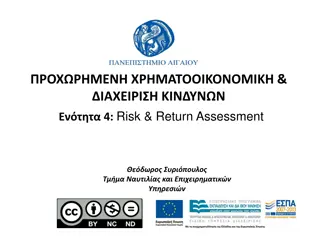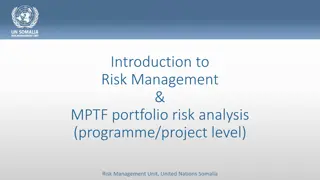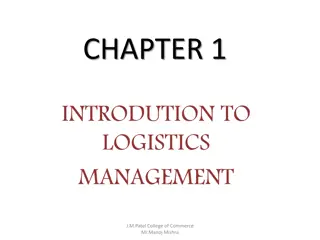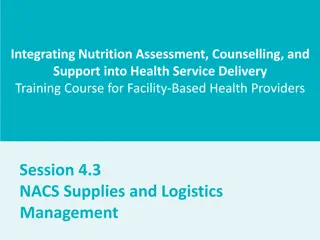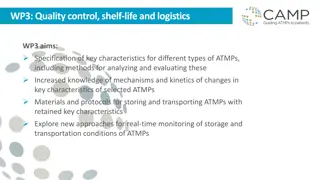Risk Management in E-Business and Logistics
Explore the significance of risk and its management in the realm of e-business and logistics. Learn strategies to effectively identify, assess, and mitigate risks in your operations. This lecture provides valuable insights into safeguarding your business from potential disruptions and ensuring smooth logistical processes.
Download Presentation

Please find below an Image/Link to download the presentation.
The content on the website is provided AS IS for your information and personal use only. It may not be sold, licensed, or shared on other websites without obtaining consent from the author.If you encounter any issues during the download, it is possible that the publisher has removed the file from their server.
You are allowed to download the files provided on this website for personal or commercial use, subject to the condition that they are used lawfully. All files are the property of their respective owners.
The content on the website is provided AS IS for your information and personal use only. It may not be sold, licensed, or shared on other websites without obtaining consent from the author.
E N D
Presentation Transcript
Lecture 2: Understanding Risk and its importance and how to manage it in e-business Risk Management in Logistics
Take home messages 1. Two common objectives to keep the e-business chain performing 2. Risk in e-business operations 3. What leads to Risk? What constitutes Risk? 4. Ways to react to Risk 5. Risk Management 6. Differentiating Risk with certainty. 2
Take home messages 1. Two common objectives to keep the e-business chain performing 2. Risk in e-business operations 3. What leads to Risk? What constitutes Risk? 4. Ways to react to Risk 5. Risk Management 6. Differentiating Risk with certainty. 3
What is needed to keep the e-business chain performing? Operations planning and management to avoid any problems that may occur. Operations planning: Various strategies by which the goal in logistics areas such as production/transportation/warehousing/inventory management etc .can be achieved with the required efficiency and effectiveness. Management to avoid any problems that may occur: Various factors that should be avoided to achieve the goal in areas such as production/transportation/warehousing/inventory management etc . In the best possible way. 4
Why do we want to avoid? Logistics area Factors to avoid Why? Manufacturing Avoid having an overstock or understock of goods Losses as a result of not meeting customers orders or having too much of stock. Procurement Not having the goods when needed Losses as a result of not having the required goods when needed. Inventory management Not having the required inventory to meet the customers demand or having excessive inventory Losses as a result of not having the required goods or having to spend excessive cost to hold. Transportation Not having the goods when needed Losses as a result of missed orders and paying more than needed. 5
What are we trying to avoid? Events that will lead us not to achieve the purpose of the activity. What type of events? o Events that represent an outcome that is different from the required or expected purpose. Why do we want to avoid such events? o Because those events will lead us (a) not to achieve the required purpose (failure), and (b) will also result in experiencing a loss. 6
Take home messages 1. Two common objectives to keep the e-business chain performing 2. Risk in e-business operations 3. What leads to Risk? What constitutes Risk? 4. Ways to react to Risk 5. Risk Management 6. Differentiating Risk with certainty. 7
What do we term the occurrence of events like these? Risk possibility of not achieving the desired purpose. More formally, risk is The likelihood that the expectations will not be achieved due to the occurrence of uncertain events at a given time, resulting in experiencing losses. Expectations Goals, specific purpose (in different areas of logistics) Likelihood Possibility, Chance Losses Negative impact 8
Risk in e-business operations Is risk important to be managed? Why? Impact is the outcome of Risk 9
Take home messages 1. Two common objectives to keep the e-business chain performing 2. Risk in e-business operations 3. What leads to Risk? What constitutes Risk? 4. Ways to react to Risk 5. Risk Management 6. Differentiating Risk with certainty. 10
What leads to Risk? Uncertainty Risk is defined in terms of the effect of uncertainty on objectives. When there is uncertainty, there is a risk of something going wrong. Why uncertainty? Because we are dealing with events of future or those which we are not sure of. 11
What constitutes Risk? 1. Uncertainty which shows the likelihood or chance of not achieving the expectations. 2. Consequences the impact of failure. Risk = Likelihood & Consequences. 12
Take home messages 1. Two common objectives to keep the e-business chain performing 2. Risk in e-business operations 3. What leads to Risk? What constitutes Risk? 4. Ways to react to Risk 5. Risk Management 6. Differentiating Risk with certainty. 13
Ways to react to Risk 1.Reactive approach Wait to see what events occur and then develop a plan to address them. 2.Proactive approach Identify the risk events in advance, analyse their chances of occurrence and determine the best response to tackle them even before they occur. 14
Reactive approach to address Risk Event: Supplier going out of business. In the reactive way, you wait for the event to happen and then react to it. -ve points: a) Wait and see approach. It is no more risk but now a problem (no uncertainty left). b) Develop a response after something has gone wrong. c) Implement the plan and then wait for it to kick in. Needs time. d) Considerable damage is done before the response becomes effective. What is it good for? a) Risk education or risk avoidance for the future similar scenarios. 15
Proactive approach to address Risk Event: Supplier going out of business. In the proactive way, you don t wait for the event to happen to react to it. Rather, you forecast it happening and already have a plan for it. +ve points: a) Identifies BEFOREHAND the uncertain factors (risk events) which will lead to the event occurring; analyse their chances of occurrence and develop appropriate plans to mitigate them. b) The plans might avoid risks events, prevent them from happening, reduce their effects and generally take actions to mitigate their effects. 16
Take home messages 1. Two common objectives to keep the e-business chain performing 2. Risk in e-business operations 3. What leads to Risk? What constitutes Risk? 4. Ways to react to Risk 5. Risk Management 6. Differentiating Risk with certainty. 17
Risk Management Series of steps by which the threats in an activity are identified beforehand and minimised to an acceptable level. Anticipating, understanding risk and deciding whether to modify it. Can we avoid or eliminate Risk? NO There is nothing as ZERO Risk May not guarantee the complete elimination of risk but at most reduce or minimise them to a certain level that is considered as acceptable beforehand. 18
helps to move from Uncertainty to Risk Risk Management Identify the uncertainty measure it both in terms of occurrence and its impact risk. The notion of Risk is used very loosely in the literature. Some infer Risk as just the uncertainty of not achieving the purpose (probability). Some infer it as the consequences of not achieving the purpose (impact). Some consider it in terms of expected value. However, Risk is a combination of both uncertainty and consequences. 19
Activity outcomes as a result of uncertainty The achievements are more than the initial expectations example - delivery received on the first day from order instead of the second day as promised. Positive outcome The achievements are similar to the initial expectations example - delivery received on the second day of order as promised Neutral outcome The achievements are less than the initial expectations example - delivery received on the third day of order instead of the second day as promised. Negative outcome 20
Uncertainty leads to both harm and benefit Uncertainty in achieving a purpose may lead to both negative and positive events to happen. Most risk management approaches however consider only those events that can lead to a negative outcome. Some experts argue this and state that risk may lead to positive outcomes too. The balance between the positive and negative effects of risk is done during risk management. 21
Types of Risks Negotiable risks Risks associated with areas such as business, operations management, finance etc., where the more the risks are taken the higher are the rewards. Risk management manages the risk to a level that is considered acceptable. Non-negotiable risks Risks associated with areas such as health, safety, security etc. in which any risk is catastrophic. Risk management controls or reduces threats. Both these types of risks need to be looked at different ways while Risk Management to develop a response. 22
Options as a result of Risk Management Depends on the type of risk you are addressing negotiable or non-negotiable? Risk Management option Activity Avoidance Withdraw or cease activity Deferment Wait and see Reduction Reduce risks to the required level Retention (Acceptance) Bear some risks for future gains. Some, but not all risk is consciously retained rather than transferred Transfer Transfer the risk to a third party Share Joint ventures to share the risks Limitation Limits the area of impact of risks 23
Take home messages 1. Two common objectives to keep the e-business chain performing 2. Risk in e-business operations 3. What leads to Risk? What constitutes Risk? 4. Ways to react to Risk 5. Risk Management 6. Differentiating Risk with certainty. 24
Differentiating Risk with certainty Uncertainty Some thing we are not sure of. Element of doubt in it. Certainty Some thing we are sure of. No element of doubt in it. 25
Classification of events while identifying Risk Certain events are those events that will occur and lead to a negative outcome these are not risks but problems. Certain events Risk events are those events that might have the capability to lead towards the occurrence of a negative outcome. Uncertain events - Risk events 27
Classification of risk events Known risk events are those for which we have a record of occurrence. Known risk events Unknown risk events are those for which we do not have a record of occurrence. Unknown risk events 28
So, to summarize what comes under risk management? see slide in animation mode We want to achieve a desired outcome has leads to Uncertainty Possible variation in desired outcome Addressed by problem arises due to gives quantification upon solving Uncertain events Certain events Chance of failure to achieve the outcome and the associated consequences classified into Unknown uncertain events Known uncertain events Addressed by Business Continuity Management 29
Risk Management for managing vulnerability quantification of -ve outcomes leads to Leads to has Uncertainty Risk Consequences Managed by Risk Management Leads to Better Decisions Supply Chain Risk Management Vulnerability and Resilience in Logistics, Donald Waters, 2007, ISBN 978074944854 7 30
Take home messages 1. Two common objectives to keep the e-business chain performing 2. Risk in e-business operations 3. What leads to Risk? What constitutes Risk? 4. Ways to react to Risk 5. Risk Management 6. Differentiating Risk with certainty. 31
